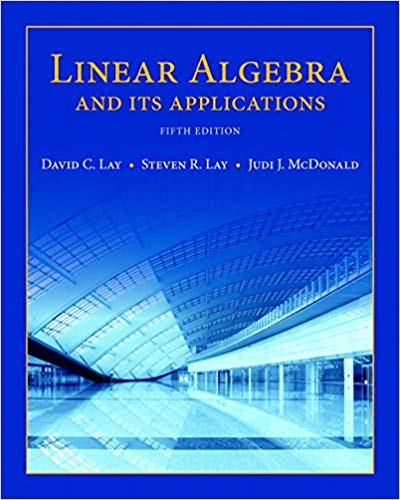
Linear Algebra and Its Applications, 5th Edition
Authors: David C. Lay, Steven R. Lay, Judi J. McDonald
ISBN-13: 978-0321982384
We have solutions for your book!
See our solution for Question 22E from Chapter 1.2 from Lay's Linear Algebra and Its Applications, 5th Edition.
Problem 22E
Chapter:
Problem:
a. The echelon form of a matrix is unique.b. The pivot positions in a matrix depend on whether row interchanges are used in the row reduction process.c. Reducing a matrix to echelon form is called
Step-by-Step Solution
Given Information
We are given with some statements, we have to prove whether they are true or false
Step-1: (a)
Statement: The echelon form of a matrix is unique
The statement is False! The echelon form must satisfy following properties:
(1) All nonzero rows are above the zero rows;
(2) All entries below the leasing entry in a column is zero;
(3)Leading entry of a row is right of the leasing entry of the above row
For a matrix there can be many forms that can satisfy these properties. However, the row-reduced echelon form is unique, that has all pivot elements equal to 1.
FALSE
Step-2: (b)
Statement: The pivot positions in a matrix depend on whether row interchanges are used in the row reduced process
The statement is False! By theorem 1, each matrix is row equivalent to one and only one reduced echelon matrix.
FALSE
Step-3: (c)
Statement: Reducing a matrix to echelon form is called the forward phase of the row reduction process.
The statement is TRUE! As stated in example-3 of the textbook, the forward phase contains 4 steps:
Step-1: Begin with the leftmost nonzero column. This is a pivot column. The pivot position is at the top.
Step-2: Select a nonzero entry in the pivot column as a pivot. If necessary, interchange rows to move this entry into the pivot position.
Step-3: Use row replacement operations to create zeros in all positions below the pivot
Step-4: Cover (or ignore) the row containing the pivot position and cover all rows, if any, above it. Apply steps 1–3 to the submatrix that remains. Repeat the process until there are no more nonzero rows to modify
TRUE
Step-4: (d)
Statement: Whenever a system has free variables, the solution set contains many solutions..
The statement is FALSE! There can be cases when the system has more variables then number of equations but the system has no solution. An example of such augmented form is shown below:
\[M = \left[ {\begin{array}{*{20}{c}}3&4&2&1\\0&7&1&{ - 2}\\0&0&0&1\end{array}} \right]\]As, the last row can never be true, the system has no solution.
FALSE
Step-5: (e)
Statement: A general solution of a system is an explicit description of all solutions of the system.
The statement is TRUE! A general solution of a system is equivalent to the parametric form of solution. We write the soltuion in terms of a parameter (free variable(s)). For different values of parameter, we obtain different solution. So The general solution describes all solution of the system.
TRUE
We are given with some statements, we have to prove whether they are true or false
Step-1: (a)
Statement: The echelon form of a matrix is unique
The statement is False! The echelon form must satisfy following properties:
(1) All nonzero rows are above the zero rows;
(2) All entries below the leasing entry in a column is zero;
(3)Leading entry of a row is right of the leasing entry of the above row
For a matrix there can be many forms that can satisfy these properties. However, the row-reduced echelon form is unique, that has all pivot elements equal to 1.
FALSE
Step-2: (b)
Statement: The pivot positions in a matrix depend on whether row interchanges are used in the row reduced process
The statement is False! By theorem 1, each matrix is row equivalent to one and only one reduced echelon matrix.
FALSE
Step-3: (c)
Statement: Reducing a matrix to echelon form is called the forward phase of the row reduction process.
The statement is TRUE! As stated in example-3 of the textbook, the forward phase contains 4 steps:
Step-1: Begin with the leftmost nonzero column. This is a pivot column. The pivot position is at the top.
Step-2: Select a nonzero entry in the pivot column as a pivot. If necessary, interchange rows to move this entry into the pivot position.
Step-3: Use row replacement operations to create zeros in all positions below the pivot
Step-4: Cover (or ignore) the row containing the pivot position and cover all rows, if any, above it. Apply steps 1–3 to the submatrix that remains. Repeat the process until there are no more nonzero rows to modify
TRUE
Step-4: (d)
Statement: Whenever a system has free variables, the solution set contains many solutions..
The statement is FALSE! There can be cases when the system has more variables then number of equations but the system has no solution. An example of such augmented form is shown below:
\[M = \left[ {\begin{array}{*{20}{c}}3&4&2&1\\0&7&1&{ - 2}\\0&0&0&1\end{array}} \right]\]As, the last row can never be true, the system has no solution.
FALSE
Step-5: (e)
Statement: A general solution of a system is an explicit description of all solutions of the system.
The statement is TRUE! A general solution of a system is equivalent to the parametric form of solution. We write the soltuion in terms of a parameter (free variable(s)). For different values of parameter, we obtain different solution. So The general solution describes all solution of the system.
TRUE